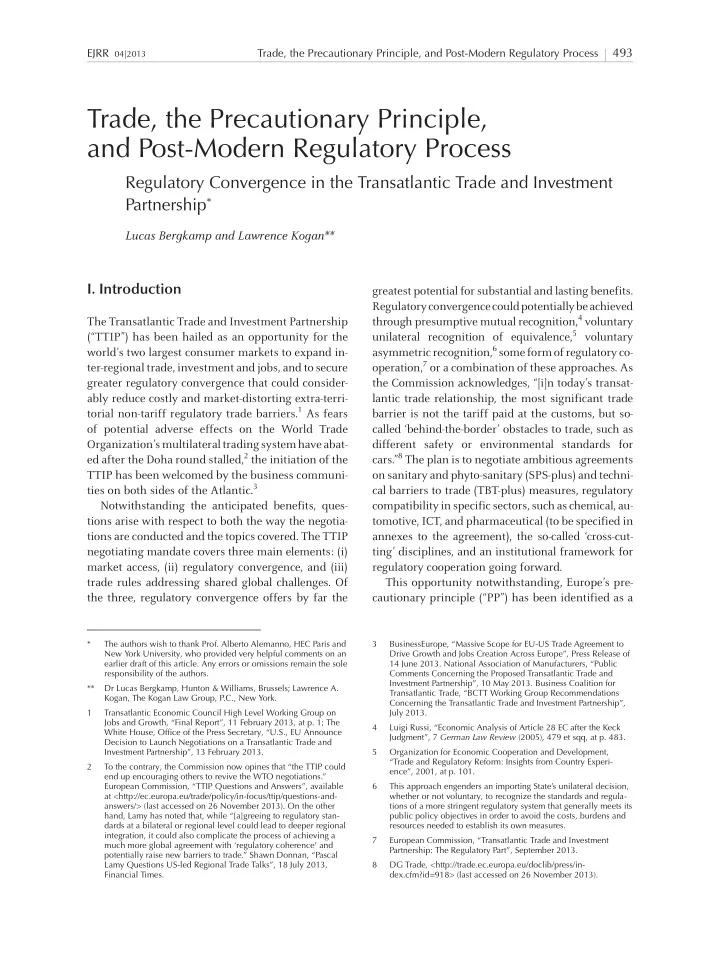

493 EJRR 04|2013 Trade, the Precautionary Principle, and Post-Modern Regulatory Process Trade, the Precautionary Principle, and Post-Modern Regulatory Process Regulatory Convergence in the Transatlantic Trade and Investment Partnership * Lucas Bergkamp and Lawrence Kogan** I. Introduction greatest potential for substantial and lasting benefits. Regulatoryconvergencecouldpotentiallybeachieved through presumptive mutual recognition, 4 voluntary The Transatlantic Trade and Investment Partnership unilateral recognition of equivalence, 5 voluntary (“TTIP”) has been hailed as an opportunity for the asymmetric recognition, 6 someform of regulatoryco- world’s two largest consumer markets to expand in- operation, 7 or a combination of these approaches. As ter-regional trade, investment and jobs, and to secure greater regulatory convergence that could consider- the Commission acknowledges, “[i]n today’s transat- ably reduce costly and market-distorting extra-terri- lantic trade relationship, the most significant trade torial non-tariff regulatory trade barriers. 1 As fears barrier is not the tariff paid at the customs, but so- of potential adverse effects on the World Trade called ‘behind-the-border’ obstacles to trade, such as Organization’smultilateraltradingsystemhaveabat- different safety or environmental standards for ed after the Doha round stalled, 2 the initiation of the cars.” 8 The plan is to negotiate ambitious agreements TTIP has been welcomed by the business communi- on sanitary and phyto-sanitary (SPS-plus) and techni- ties on both sides of the Atlantic. 3 cal barriers to trade (TBT-plus) measures, regulatory Notwithstanding the anticipated benefits, ques- compatibility in specific sectors, such as chemical, au- tions arise with respect to both the way the negotia- tomotive, ICT, and pharmaceutical (to be specified in tions are conducted and the topics covered. The TTIP annexes to the agreement), the so-called ‘cross-cut- negotiating mandate covers three main elements: (i) ting’ disciplines, and an institutional framework for market access, (ii) regulatory convergence, and (iii) regulatory cooperation going forward. trade rules addressing shared global challenges. Of This opportunity notwithstanding, Europe’s pre- the three, regulatory convergence offers by far the cautionary principle (“PP”) has been identified as a * The authors wish to thank Prof. Alberto Alemanno, HEC Paris and 3 BusinessEurope, “Massive Scope for EU-US Trade Agreement to New York University, who provided very helpful comments on an Drive Growth and Jobs Creation Across Europe”, Press Release of earlier draft of this article. Any errors or omissions remain the sole 14 June 2013. National Association of Manufacturers, “Public responsibility of the authors. Comments Concerning the Proposed Transatlantic Trade and Investment Partnership”, 10 May 2013. Business Coalition for ** Dr Lucas Bergkamp, Hunton & Williams, Brussels; Lawrence A. Transatlantic Trade, “BCTT Working Group Recommendations Kogan, The Kogan Law Group, P.C., New York. Concerning the Transatlantic Trade and Investment Partnership”, 1 Transatlantic Economic Council High Level Working Group on July 2013. Jobs and Growth, “Final Report”, 11 February 2013, at p. 1; The 4 Luigi Russi, “Economic Analysis of Article 28 EC after the Keck White House, Office of the Press Secretary, “U.S., EU Announce Judgment”, 7 German Law Review (2005), 479 et sqq, at p. 483. Decision to Launch Negotiations on a Transatlantic Trade and Investment Partnership”, 13 February 2013. 5 Organization for Economic Cooperation and Development, “Trade and Regulatory Reform: Insights from Country Experi- 2 To the contrary, the Commission now opines that “the TTIP could ence”, 2001, at p. 101. end up encouraging others to revive the WTO negotiations.” European Commission, “TTIP Questions and Answers”, available 6 This approach engenders an importing State’s unilateral decision, at <http://ec.europa.eu/trade/policy/in-focus/ttip/questions-and- whether or not voluntary, to recognize the standards and regula- answers/> (last accessed on 26 November 2013). On the other tions of a more stringent regulatory system that generally meets its hand, Lamy has noted that, while “[a]greeing to regulatory stan- public policy objectives in order to avoid the costs, burdens and dards at a bilateral or regional level could lead to deeper regional resources needed to establish its own measures. integration, it could also complicate the process of achieving a 7 European Commission, “Transatlantic Trade and Investment much more global agreement with ‘regulatory coherence’ and Partnership: The Regulatory Part”, September 2013. potentially raise new barriers to trade.” Shawn Donnan, “Pascal Lamy Questions US-led Regional Trade Talks”, 18 July 2013, 8 DG Trade, <http://trade.ec.europa.eu/doclib/press/in- Financial Times. dex.cfm?id=918> (last accessed on 26 November 2013).
Recommend
More recommend